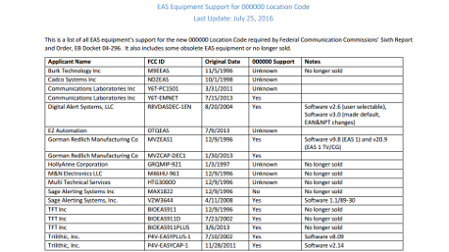Guide Offers Details on EAS Equipment
SAN FRANCISCO—When it comes to the readiness of different EAS equipment to support the new all-zero EAS location code, it can be tough to keep track of what’s what.
One interested EAS onlooker is attempting to address that by putting together a comprehensive summary on EAS equipment supporting the new 000000 location code.

EAS Equipment Support for 000000 Location Code
EAS observer Sean Donelan has laid out a list of both minor and major EAS equipment manufacturers and the support that these manufacturers are offering for the new 000000 national location code that’s now required by the Federal Communication Commission’s Sixth Report and Order. The national EAS test message will be used during the upcoming Sept. 28 national test.
The document includes the manufacturer’s name, the FCC ID number, its original date of manufacturer and whether the manufacturer is supporting the six-zero location code.
The most current version of Donelan’s document includes updates from vendors themselves.
One of his goals was to consolidate information about all equipment being used, beyond just the major EAS suppliers. “[I am also trying] to find out from the community what legacy — i.e. over 10-years old— EAS equipment is still being used in the field,” he said.
The professional video industry's #1 source for news, trends and product and tech information. Sign up below.
“Trying to grandfather old equipment is a good thing,” Donelan said, “but at some point trying to accommodate very old equipment makes everything more complicated, and less reliable.”
Donelan will continue to update the document as new updates are made. The list also includes some obsolete equipment or EAS gear that is no longer being sold.
Ten years ago, Donelan worked for a telephone company inaugurating a new IPTV pay TV network, which needed to provide EAS capabilities on IPTV set-top boxes. “I spent about a year learning everything I could about EAS, how it worked, what the rules were, what the problems are, etc.,” he said. “As part of making EAS work over IPTV, I also evaluated multiple EAS equipment vendors and their equipment” by testing different boxes, and in the process found various quirks and oddities in how different vendors did things, he said. “There were many unresolved issues with EAS rules.”
That IPTV system has a working EAS now, Donelan said. Though he no longer works directly with EAS, he regularly offers suggestions to the FCC and to industry groups to improve public alerting, EAS and WEA. “Instead of looking at public warnings only from a radio point-of-view, or only from the cable TV point-of-view, or only from the cellphone point-of-view, I’ve tried to point out problems and how they can all improve,” he said.
This story first appeared on TV Technology's sister publication, Radio World.
Susan Ashworth is the former editor of TV Technology. In addition to her work covering the broadcast television industry, she has served as editor of two housing finance magazines and written about topics as varied as education, radio, chess, music and sports. Outside of her life as a writer, she recently served as president of a local nonprofit organization supporting girls in baseball.

